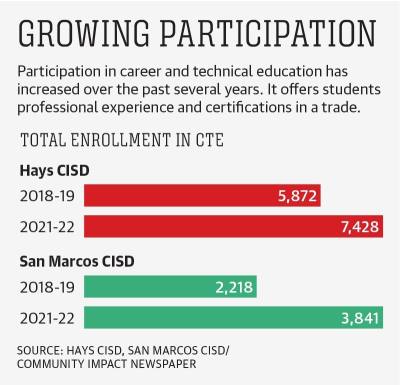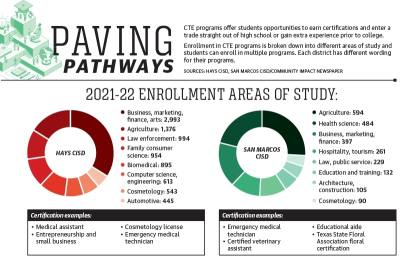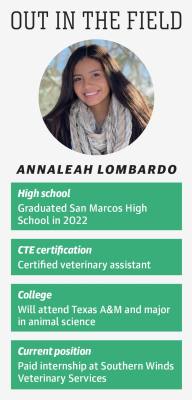“10 years ago we had this culture where we were telling kids that every kid had to go to college, and that has really changed. As a society, we have realized we need electricians and we need plumbers and we need welders; every one of those careers can be a very lucrative career with good benefits, good pay,” HCISD CTE Director Suzi Mitchell said. “You do not necessarily have to go to college to be very successful in life, so because of that, our CTE programs have just exploded, and they are growing.”
Student participation in CTE programs at HCISD has increased 7% over the past nine years. In the 2013-14 school year, 4,365 out of 17,255 students were enrolled in CTE classes, or about 25%; In the 2021-22 school year, 7,428 out of 22,932 students were enrolled in CTE classes, or about 32%.
Both districts offer more than 20 programs of study that range from accounting to culinary arts to nursing. The CTE programs offer rudimentary and hands-on courses that build on each other, after which students can earn an Industry Based Certification, or IBC.
Engaging the students
As student participation has increased over the years, so has the attitude surrounding CTE programs as a viable piece of the overall education system, SMCISD CTE Coordinator Clayton Odam said. CTE programs and classes used to be seen as a last resort to engage students, whereas now, it is seen as a driver for student engagement and participation.
“[There are] countless examples that I can point to that I have seen over the years where [a student] was wandering, was getting into behavioral issues, did not have the best grades. ... Once they found athletics or once they found choir or once they found a CTE program, again, that was maybe why they got out of bed but then they also behaved better and performed better,” Odam said. “For us, getting kids engaged becomes the key.”
To further increase engagement, Odam said the district is actively working on outreach to the elementary schools so students can witness what the possibilities are once they get to high school. CTE classes are typically geared toward high school students with four-year programs and pathways. However, some start as early as seventh grade.
“The more I can get kids engaged and see that there is a life beyond middle school, beyond high school, ... the more they get hooked into school,” SMCISD Director of Curriculum and Instruction Kieth Cunningham said.
CTE courses happen concurrently with the curriculum and the knowledge learned in classes such as math or English help students with the “real-world” application of those abstract concepts, Odam said.
“[CTE] becomes the answer to the kids’ question of, ‘Why do I have to learn this?’” Odam said.
Real-world application
Growing up on a farm and around livestock, Annaleah Lombardo said she knew she wanted to pursue a career in veterinary medicine when she was 4 years old. Lombardo joined the animal science program under the Agricultural, Food and Natural Resources CTE at San Marcos High School where she received the certified veterinary assistant certification.
However, students do not need an extensive background to join a CTE program, Lombardo said.
“You can come in knowing nothing, and they will teach you everything from scratch,” Lombardo said. “The teachers are very flexible, and they are willing to work with you and your schedule.”
In her last year at SMHS, Lombardo was eligible to take on an internship at a local veterinary clinic where she now has a paid position.
“I get so many questions about how I am going to get my CVA, and I [said] my school offers it,” Lombardo said. “I think it is such a cool program that it allows kids to get their CVA license because when you apply to a veterinarian, the first thing they ask you is if you have any type of certification. ... Most say no.”
Aside from the certification through the CTE program, Lombardo said that it has helped her with other valuable life skills such as preparing for a job interview, writing a resume, communication skills and public speaking.
Breaking down barriers
The ultimate objective of CTE programs is to provide students with ample opportunities, Odam said.
There are no GPA requirements that need to be met in order for a student to participate in a CTE like they might have to for athletics, Odam said. The courses become more and more hands-on as the students progress through high school, and while barriers might pop up, such as a fee or transportation needs, the district said it will work to help bridge the gap to meet the students’ needs.
“I think about a kid that has nothing, living in one of our poorest neighborhoods with no resources. They have lost every round of the life lottery up to this point. This is available to them; just come to school every day,” Odam said. “We will hand you a diploma and this other piece of paper and you can take them to that other business and they will start paying you more money than your family has ever seen. To leave school with a diploma is what you are supposed to do. But you would have really left a lot on the table if that is all you left with from San Marcos High School.”








